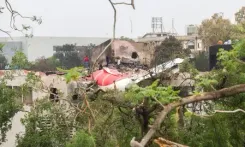What Does the Inauguration of the 91.35-km Gorakhpur Link Expressway Mean for Uttar Pradesh?

Synopsis
Key Takeaways
- The Gorakhpur Link Expressway spans 91.35 km.
- Constructed at a cost of Rs 7,283 crore.
- Enhances connectivity between Gorakhpur and other districts.
- Features an advanced safety fleet and traffic management system.
- Ambulance services are available every 45 km for emergencies.
Lucknow, June 20 (NationPress) The Chief Minister of Uttar Pradesh, Yogi Adityanath, officially opened the 91.35-km Gorakhpur Link Expressway on Friday, further enhancing the state's highway infrastructure.
This expressway, constructed at a staggering cost of Rs 7,283 crore, is seen as a pivotal gateway to growth and development for the region, linking Gorakhpur—previously the Chief Minister's Lok Sabha constituency—to numerous districts, including Azamgarh.
The expressway features comprehensive road and commuter safety measures, including a specialized safety fleet. This fleet comprises five Innovas, five Campers, four ambulances, two cranes, and one hydra vehicle, all set to patrol the expressway round the clock.
The Advanced Traffic Management System (ATMS) has been implemented, similar to that of the Lucknow-Agra Expressway, providing continuous oversight and law enforcement.
Managed by the Uttar Pradesh Expressways Industrial Development Authority, this fleet will ensure safety across the expressway, with ex-servicemen supervising operations in shifts. Moreover, ambulance services are positioned every 45 km for prompt emergency response.
The camper vehicles, designed with open rear access, will carry essential tools such as traffic cones, ropes, and radium strips to swiftly manage accidents or breakdowns, ensuring minimal disruption to other drivers.
Along the expressway's 91-km stretch, cranes will be strategically placed every 45 km, along with one hydra vehicle, to assist in vehicle recovery. In case of breakdowns, small and medium vehicles will be towed using cranes, while larger vehicles will be relocated to the nearest chainage point.
The ATMS includes CCTV cameras installed every five kilometers, monitored from a centralized control room, alongside speed cameras and number plate readers to identify and report violations.
Instances of speeding will be automatically relayed to the district's Assistant Regional Transport Officer for immediate action.






